You can edit a knowledge graph in a link chart. You can create entities and relationships, delete entities and relationships, and edit properties of existing entities and relationships.
Note:
Editing a knowledge graph's data and data model in ArcGIS AllSource is not supported when the knowledge graph uses a NoSQL data store with user-managed data.
Create an entity
To create an entity, first open the Create Entities pane. Click an entity feature template for the link chart layer associated with the appropriate entity type. Click the forward arrow  next to the tool palette to define the entity's properties before creating the entity. Finally, create a feature that defines the new entity.
next to the tool palette to define the entity's properties before creating the entity. Finally, create a feature that defines the new entity.
- On the Edit tab in the Entities group, click Create
 .
.The Create Entities pane appears.
- Click an entity feature template, and click the Active Template button
 .
.The Active Template opens in the Create Entities pane.
- Type the property values you want to apply to the new entity.
- Click the link chart to create the entity.
- When you are finished defining entities, save your changes. On the Edit tab, in the Manage Edits group, click Save
 .
.The Save Edits dialog box appears.
- Click Yes to save your edits to the knowledge graph.
To learn more, see Save or discard edits.
Tip:
To edit an entity's property values after creating it, on the Edit tab, click Attributes  and select the entity in the link chart.
and select the entity in the link chart.
Create a relationship
You can create relationships on a link chart using the same method you use to create entities between existing entities that are present on the link chart. Alternatively, you can open the Create Relationship editing tool using the keyboard and use it to create entity types and relationship types and define new properties as you create relationships between entities.
Use the Create Entities pane
To create a relationship following the same workflows as for editing spatial data, first ensure the appropriate entities are present on the link chart. In the Create Entities pane, use the relationship feature template for the link chart layer associated with the appropriate relationship type. Click the forward arrow  next to the tool palette to define property values before creating the relationship. Finally, create a feature that connects one entity to another, defining the new relationship.
next to the tool palette to define property values before creating the relationship. Finally, create a feature that connects one entity to another, defining the new relationship.
- On the Edit tab in the Entities group, click Create
 .
.The Create Entities pane appears.
- Click a relationship feature template, and click the Active Template button
 .
.The Active Template opens in the Create Entities pane.
- Type the property values you want to apply to the new relationship.
- In the link chart, click an entity to define it as the source of the relationship.
- Click an entity to define it as the destination of the relationship.
Before you click the destination entity, a pop-up appears indicating what type of relationship will be created between the source entity and the entity under the pointer. The pop-up identifies the two entities and their entity types. If this is the relationship you want to create, click the destination entity.
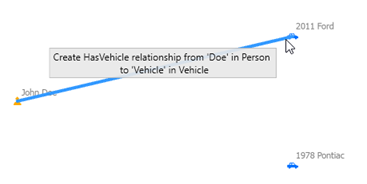
The relationship is created and appears in the link chart as a line with an arrow pointing from the source entity to the target entity.
- When you finish defining relationships, save your changes. On the Edit tab, in the Manage Edits group, click Save
 .
.The Save Edits dialog box appears.
- Click Yes to save your edits to the knowledge graph.
To learn more, see Save or discard edits.
Tip:
To edit a relationship's property values after creating it, on the Edit tab, click Attributes  and select the relationship in the link chart.
and select the relationship in the link chart.
Use the Create Relationship editing tool
To create a relationship and edit the knowledge graph's data model at the same time, open the radial menu using the keyboard and choose the Create Relationship editing tool. Choose an existing relationship type or define a new relationship type if one is needed. The destination entity for the relationship can be an entity on the link chart, an existing entity that is not on the link chart, or a new entity if one is needed. You can define properties for the new relationship and new entities before creating the relationship.
- On the Link Chart tab on the ribbon, in the Selection group, click the Select drop-down list and check Select and Move at the bottom of the list.
The active selection mode is checked and the drop-down list indicates you are using the Select and Move tool
 .
. - Use the selection tool to select the origin entity for the relationship on the link chart by drawing the shape associated with the tool.
- Press Alt+R to open the radial menu.
Operations supported for the selected graph items are available from this menu.
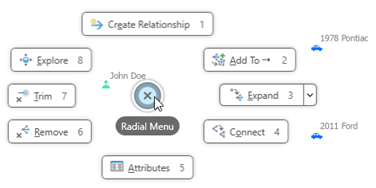
- Press 1 to select the Create Relationship tool.
An orange circle appears around the selected entity that will be the origin of the relationship, and an orange line appears that allows you to draw the relationship.
- Click the destination entity in the link chart.
- Hover over the destination entity on the link chart. When an orange circle appears, click the entity.
- Click an empty space on the link chart to identify an entity that is not present as the destination entity.
The Create Relationship dialog box appears.
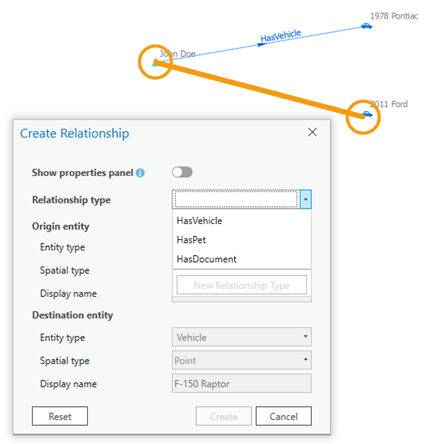
- Click the Relationship type drop-down list and click the type of relationship that exists between the two entities. Alternatively, type the name of a new relationship type to create.
- Optionally, click the Swap Origin/Destination Entity button
 to reverse the direction of the relationship.
to reverse the direction of the relationship. - If you clicked an empty space on the link chart, identify the destination entity that participates in the relationship.
- Under the Destination entity heading, click the Entity type drop-down list and click the type of entity that participates in the relationship. Alternatively, type the name of a new entity type to create.
- Click in the Display name text box.
- Type a keyword to search for an existing entity and click the appropriate entity in the search results list. Or, leave the Display name text box empty to create an entity.
- Optionally, define properties for the new relationship and the new entity, as appropriate.
- Click the Show properties panel toggle button.
A panel appears at the side of the dialog box. The relationship type is listed at the top and selected.
- Define properties for the new relationship. For an existing relationship type, click a property, click in the Value column, and type a suitable value. For a new relationship type, define a new property, click in the Value column, and type a suitable value.
- To define properties for a new destination entity, click the entity type at the top of the panel. Define properties for the entity in the same manner as you define properties for a relationship.
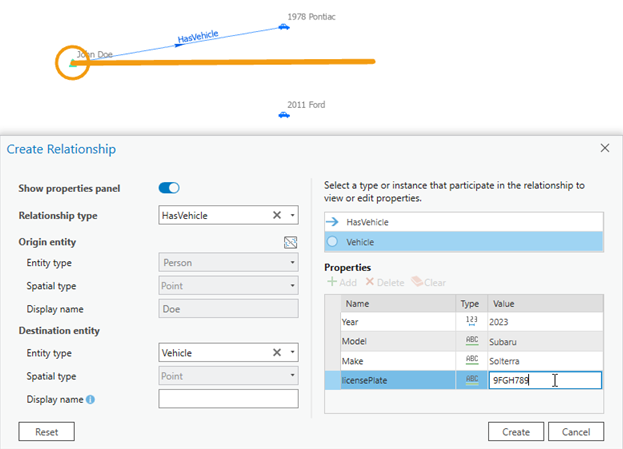
- Click the Show properties panel toggle button.
- Click Create.
If the destination entity was not present on the link chart, the destination entity is added. The new relationship is created and is selected on the link chart.
- On the Edit tab, in the Manage Edits group, click Save
 .
.The Save Edits dialog box appears.
- Click Yes to save your edits to the knowledge graph.
To learn more, see Save or discard edits.
Edit properties of entities and relationships
You can edit property values for existing entities and relationships by selecting them in the link chart. Open the Attributes pane  , and edit properties for one or more of the selected entities or relationships at a time.
, and edit properties for one or more of the selected entities or relationships at a time.
- On the Edit tab, in the Selection group, click Attributes
 .
.
- Select the entities or relationships you want to edit.
Each selected item in each link chart layer is listed at the top of the Attributes pane.
- Expand a layer in the Attributes pane to see the entities or relationships that were selected. In the list, select one or more entities or relationships whose property values you want to edit.
- To update values for all selected items, click the layer's name in the pane.
- To select multiple entities and edit the same field with the same value, use the following keyboard shortcuts:
- To select multiple items, press Ctrl while clicking the entities or relationships in the list.
- To select adjacent items in the list, press Shift while clicking the first and last entities or relationships.
- Check or uncheck Auto Apply.
- Check Auto Apply to apply your edits automatically when you press Enter.
- Uncheck Auto Apply to apply your edits when you click Apply. Edited fields are highlighted with a green vertical bar until you apply your changes.
- Click the Attributes tab to edit property values.
- Click the cell you want to edit, change the value, and press Enter.
- To change a date property using the calendar, click the cell and click Calendar
 . To enter the current date and time, click Today.
. To enter the current date and time, click Today.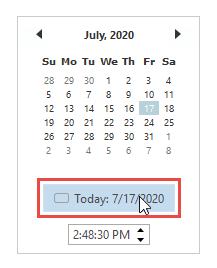
- To set a property that accepts null values to Null, right-click and click Set To '<Null>'.
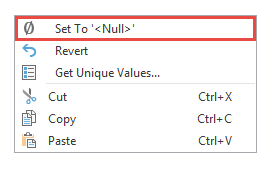
- To change a date property using the calendar, click the cell and click Calendar
- If Auto Apply is turned off, click Apply.
- To cancel the edited value, click Cancel.
Note:
If you do not apply or cancel your edits for the selected entities or relationships before switching to a map or an investigation, you are prompted to apply or cancel any uncommitted edits.
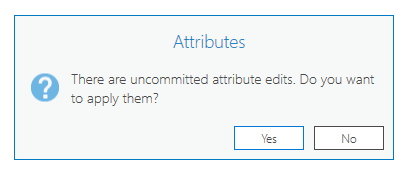
Delete entities and relationships
After selecting entities and relationships in a link chart, you can permanently delete them from the knowledge graph if they are no longer needed in any aspect of your investigation.
If you want to remove the selected entities and relationships from the link chart without permanently deleting them, use the Remove button  instead.
instead.
Learn about removing graph items from a link chart
There are important details to remember when deleting content from a link chart.
- When one relationship is selected, only the selected relationship is deleted. The origin and destination entities in the relationship are not deleted.
- If one relationship group is selected, all individual relationships that participate in the group are deleted.
- When one entity is selected, any relationship associated with the entity is also deleted, even if the relationship is not present in the link chart. A relationship must have both an origin and a destination entity in the knowledge graph.
- If one entity group is selected, all individual entities that participate in the group are deleted, along with all relationships and relationship groups associated with those entities.
To delete entities and relationships as you work with a link chart, complete the following steps:
- Select entities or relationships you want to delete.
- In the Entities group, click Delete
 .
.The selected entities and relationships are removed from the active link chart and deleted from the knowledge graph.
Note:
These edits are cached locally until they are saved or discarded. Other people working with the same knowledge graph won't see your changes until you save your edits. They might have to restart ArcGIS AllSource to refresh their local cache and see these changes. - When you are finished, save your changes. On the Edit tab, in the Manage Edits group, click Save
 .
.The Save Edits dialog box appears.
- Click Yes to save your edits to the knowledge graph.
To learn more, see Save or discard edits.
The deleted entities and relationships no longer appear in any open link charts, maps and scenes, or investigations where they were previously included.
If grouped entities in an entity group are deleted, the count on the entity group instantaneously decreases accordingly. Similarly, the count on a relationship group is instantaneously decreased if grouped relationships are deleted.